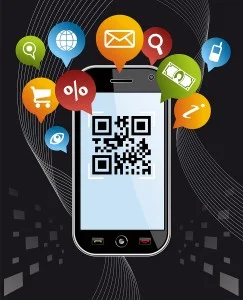What Is A QR Code?
Have you noticed the strange looking bar codes popping up lately, on websites, in publications, on business cards? These are QR Codes, used to provide instant information to smart phones.
Where traditional one-dimensional barcodes (like the ones on the back of books) can store small bits of information (such as the price of a book), a QR code has a larger storage capacity and, crucially for writer/publishers, can re-direct scanners to websites for more detailed information.
How Do QR Codes Work?
Smart phones can scan a QR code from a screen or a page, saving a reader from having to fiddle about with website addresses and search engines, allowing them quick access to whatever information you want them to have.
All that is necessary is that the phone has a QR code reader, easily downloadable to any smart phone or device.
The code is downloaded as a .jpg, .png or .eps file, depending on whether you'll be using screen or print to deliver it to readers.
Use the QR code to take readers wherever you want them to go: a sales page, your new book information on your website, your Amazon Author Page… It's your choice.
How Do I Get A QR Code?
There are a number of free QR Code generator sites. Here's a list from Freenuts.com: Top 10 Free Online QR Code Generators.
Where Should I Put The QR Code?
You are limited only by your imagination. Some possibilities include:
- In your email signature
- On a poster at your book signing
- On your business card
- On a bookmark
- On your website (perhaps pointing to a sales or squeeze page)
- On your social media
- On the back cover of your book to take your reader to another publication
OVER TO YOU: Have you used QR codes? How? Any cool ideas for how self-publishers can use them to promote? Comments welcome and appreciated below.





It’s going to be end of mine day, however before end I am reading
this impressive paragraph to increase my experience.
[…] the code to look deeper into the world they’ve enjoyed exploring in the pages of the book. Authors may link up to a microsite featuring activities, exclusive content, or in-depth character bios. It’s a great way for […]
Here’s one crucial thing about using QR codes that a lot of people don’t consider.
Almost everyone using QR codes does so on a phone – so the link opens in a small phone browser, not a desktop browser.
That means that unless your website can be properly viewed on a mobile device, using a QR code is a waste of time and a frustrating experience for the user.
Before going to the trouble of creating QR codes, make sure your website either has mobile version or uses a technique called “responsive design”, which resizes the content to fit small screen mobile devices like phones and still be readable.
[…] have it printed on your book poster or post cards, so they can order/buy from their smart phone (see our post about QR codes here). Have some book plates printed (on mailing labels) for you to "autograph" as a […]
[…] Â Link to the original article: https://selfpublishingadvice.org/how-indie-authors-use-qr-codes/ […]
Is there some way you guys could link all these posts together? I’m having a really hard time finding the others on my smartphone. Or perhaps link the ones that come before/after each one (link this one to #7 and #9). That would help us move through them all as they come out. Thanks!
Yes, I use QR codes. Just discovered something: they can work even if your poster is in a display. I put a poster inside the header/backdrop area of a large clear acrylic table display raffle box. I was offering a contest to win a free copy of my next book. The poster behind the acrylic panel contained a QR code to view the promo about the book. Do check to make sure your code works through your display material. I was thrilled that it worked – my poster looked much snazzier behind (inside) the display!